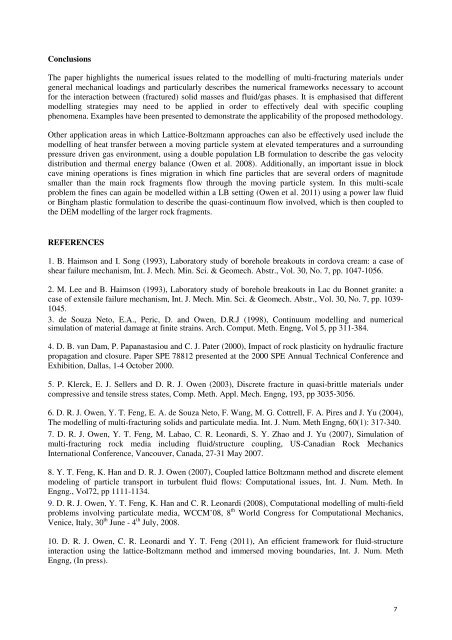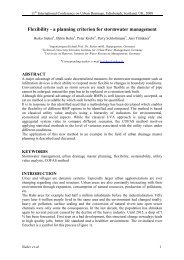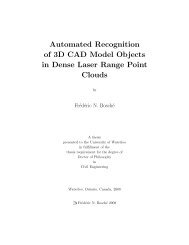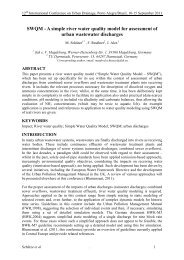ACME 2011 Proceedings of the 19 UK National Conference of the ...
ACME 2011 Proceedings of the 19 UK National Conference of the ...
ACME 2011 Proceedings of the 19 UK National Conference of the ...
You also want an ePaper? Increase the reach of your titles
YUMPU automatically turns print PDFs into web optimized ePapers that Google loves.
Conclusions<br />
The paper highlights <strong>the</strong> numerical issues related to <strong>the</strong> modelling <strong>of</strong> multi-fracturing materials under<br />
general mechanical loadings and particularly describes <strong>the</strong> numerical frameworks necessary to account<br />
for <strong>the</strong> interaction between (fractured) solid masses and fluid/gas phases. It is emphasised that different<br />
modelling strategies may need to be applied in order to effectively deal with specific coupling<br />
phenomena. Examples have been presented to demonstrate <strong>the</strong> applicability <strong>of</strong> <strong>the</strong> proposed methodology.<br />
O<strong>the</strong>r application areas in which Lattice-Boltzmann approaches can also be effectively used include <strong>the</strong><br />
modelling <strong>of</strong> heat transfer between a moving particle system at elevated temperatures and a surrounding<br />
pressure driven gas environment, using a double population LB formulation to describe <strong>the</strong> gas velocity<br />
distribution and <strong>the</strong>rmal energy balance (Owen et al. 2008). Additionally, an important issue in block<br />
cave mining operations is fines migration in which fine particles that are several orders <strong>of</strong> magnitude<br />
smaller than <strong>the</strong> main rock fragments flow through <strong>the</strong> moving particle system. In this multi-scale<br />
problem <strong>the</strong> fines can again be modelled within a LB setting (Owen et al. <strong>2011</strong>) using a power law fluid<br />
or Bingham plastic formulation to describe <strong>the</strong> quasi-continuum flow involved, which is <strong>the</strong>n coupled to<br />
<strong>the</strong> DEM modelling <strong>of</strong> <strong>the</strong> larger rock fragments.<br />
REFERENCES<br />
1. B. Haimson and I. Song (<strong>19</strong>93), Laboratory study <strong>of</strong> borehole breakouts in cordova cream: a case <strong>of</strong><br />
shear failure mechanism, Int. J. Mech. Min. Sci. & Geomech. Abstr., Vol. 30, No. 7, pp. 1047-1056.<br />
2. M. Lee and B. Haimson (<strong>19</strong>93), Laboratory study <strong>of</strong> borehole breakouts in Lac du Bonnet granite: a<br />
case <strong>of</strong> extensile failure mechanism, Int. J. Mech. Min. Sci. & Geomech. Abstr., Vol. 30, No. 7, pp. 1039-<br />
1045.<br />
3. de Souza Neto, E.A., Peric, D. and Owen, D.R.J (<strong>19</strong>98), Continuum modelling and numerical<br />
simulation <strong>of</strong> material damage at finite strains. Arch. Comput. Meth. Engng, Vol 5, pp 311-384.<br />
4. D. B. van Dam, P. Papanastasiou and C. J. Pater (2000), Impact <strong>of</strong> rock plasticity on hydraulic fracture<br />
propagation and closure. Paper SPE 78812 presented at <strong>the</strong> 2000 SPE Annual Technical <strong>Conference</strong> and<br />
Exhibition, Dallas, 1-4 October 2000.<br />
5. P. Klerck, E. J. Sellers and D. R. J. Owen (2003), Discrete fracture in quasi-brittle materials under<br />
compressive and tensile stress states, Comp. Meth. Appl. Mech. Engng, <strong>19</strong>3, pp 3035-3056.<br />
6. D. R. J. Owen, Y. T. Feng, E. A. de Souza Neto, F. Wang, M. G. Cottrell, F. A. Pires and J. Yu (2004),<br />
The modelling <strong>of</strong> multi-fracturing solids and particulate media. Int. J. Num. Meth Engng, 60(1): 317-340.<br />
7. D. R. J. Owen, Y. T. Feng, M. Labao, C. R. Leonardi, S. Y. Zhao and J. Yu (2007), Simulation <strong>of</strong><br />
multi-fracturing rock media including fluid/structure coupling, US-Canadian Rock Mechanics<br />
International <strong>Conference</strong>, Vancouver, Canada, 27-31 May 2007.<br />
8. Y. T. Feng, K. Han and D. R. J. Owen (2007), Coupled lattice Boltzmann method and discrete element<br />
modeling <strong>of</strong> particle transport in turbulent fluid flows: Computational issues, Int. J. Num. Meth. In<br />
Engng., Vol72, pp 1111-1134.<br />
9. D. R. J. Owen, Y. T. Feng, K. Han and C. R. Leonardi (2008), Computational modelling <strong>of</strong> multi-field<br />
problems involving particulate media, WCCM’08, 8 th World Congress for Computational Mechanics,<br />
Venice, Italy, 30 th June - 4 th July, 2008.<br />
10. D. R. J. Owen, C. R. Leonardi and Y. T. Feng (<strong>2011</strong>), An efficient framework for fluid-structure<br />
interaction using <strong>the</strong> lattice-Boltzmann method and immersed moving boundaries, Int. J. Num. Meth<br />
Engng, (In press).<br />
7













